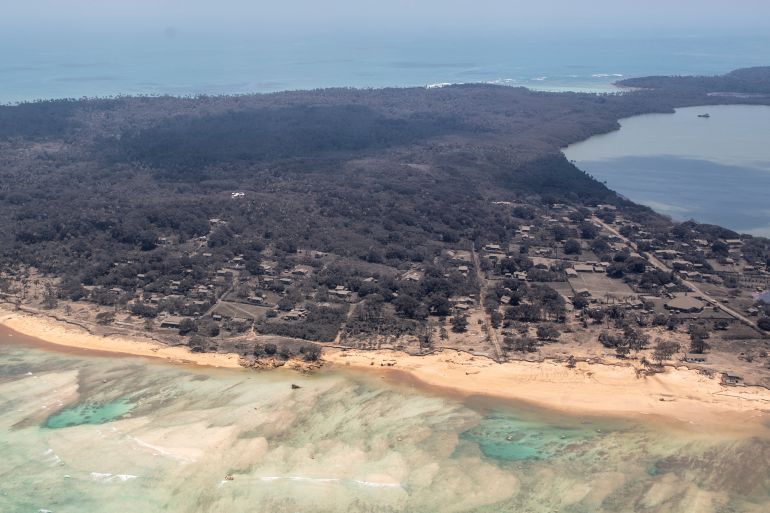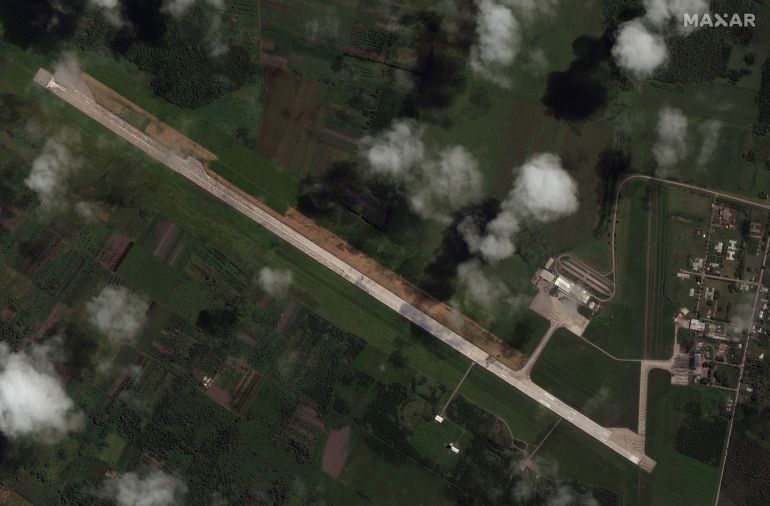Tonga says facing ‘unprecedented disaster’, UN prepares relief
With at least three confirmed dead, UN says aid operations could be conducted remotely because of the COVID-19 risk.

The Tonga government says the Pacific island nation is facing an “unprecedented disaster” after a massive volcanic eruption triggered a tsunami and blanketed parts of the country of 100,000 people in thick volcanic ash.
In its first statement since the undersea volcano Hunga Tonga-Hunga Ha’apai erupted on Saturday, the prime minister’s office late on Tuesday confirmed the deaths of at least three people, including a British woman.
Keep reading
list of 4 itemsSatellite images show extent of damage in Tonga eruption
Scientists warn Tonga eruption may damage environment for years
‘Much remains unknown’: Tonga still cut off by volcanic eruption
“As a result of the eruption, a volcanic mushroom plume was released reaching the stratosphere and extending radially covering all Tonga Island, generating tsunami waves rising up to 15 metres (49 feet), hitting the west coasts of Tongatapu Islands, ‘Eua and Ha’apai Islands,” the statement said.
“Due to the severity of the damage observed”, the government said additional rescue teams had been sent to Mango, Fonoifua and Nomuka islands. All houses on Mango – where a distress signal had been detected – had been destroyed and only two remained standing on Fonoifua, while there was extensive damage on Nomuka, it said.
Tongan navy ships were being sent to affected islands with urgent supplies of water and food, while evacuation efforts from the worst-hit areas were also under way.
The eruption was the largest since Pinatubo in the Philippines in 1991, with the cataclysmic bang heard in Fiji more than 750km (466 miles) away.
Two ships from the New Zealand navy, carrying rescue teams and equipment and loaded with supplies, are already on their way to Tonga and are expected to arrive on Friday depending on the weather conditions.
The United Nations said it was ready to provide assistance, but might have to do so remotely because of the coronavirus pandemic.
“Tonga has a very strict Covid-free policy – they’re one of the few countries in the world that has remained COVID-free,” Jonathan Veitch, the UN co-ordinator in Fiji, told reporters on Wednesday morning, noting the UN had just over 20 people on the ground who would be able to organise any emergency response. “We won’t be doing anything to threaten the safety of their protocols and the safety of their population in terms of COVID-19 because that would cause us a lot more difficulties than we already have.”

Attempts to respond to the disaster are also being hampered by communication problems after the eruption severed the islands’ undersea cable, and by thick ash covering the runway at the country’s main airport.
Veitch said attempts to clear the runway had made “quite good progress” but not to the stage where aircraft would be able to land, and ash was also still falling. While there is damage on the coast and at the main port, he said it was still possible for ships to dock.
The Red Cross, meanwhile, said securing access to safe drinking water was a “critical immediate priority”.
It said the Tongan Red Cross had reported widespread stagnant pools of salt water as a result of the tsunami as well as ash contamination of fresh water supplies.
“Red Cross teams are urgently delivering drinking water and relief kits for people who have lost everything,” Katie Greenwood, the Pacific Head of Delegation for the International Federation of Red Cross and Red Crescent Societies (IFRC), said in an emailed statement. “It is heartbreaking and devastating for these remote island communities.”
Simon Griffiths, the captain of the HMNZS Aotearoa, one of the New Zealand ships on their way to Tonga, said the vessel was carrying more than 250,000 litres of fresh water in addition to water storage facilities and generators.
Once in Tonga, it would also have the capacity to produce 70,000 litres of water every day, he added in a video shared on Twitter.
WATCH🎬 We’ve set sail, and we’re bringing help.
Prior to departing #DevonportNavalBase last night, #HMNZSAotearoa‘s Commanding Officer, CAPT Simon Griffiths, described the role his ship will be performing in #Tonga and the supplies they are carrying to the Kingdom.#NZNavy pic.twitter.com/1nk7pGDvLy
— Royal NZ Navy (@NZNavy) January 19, 2022